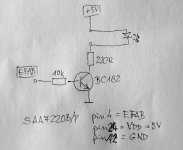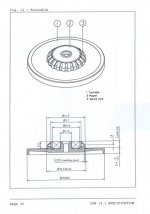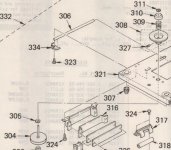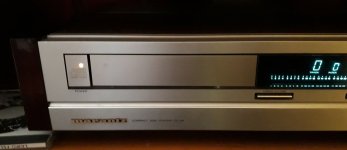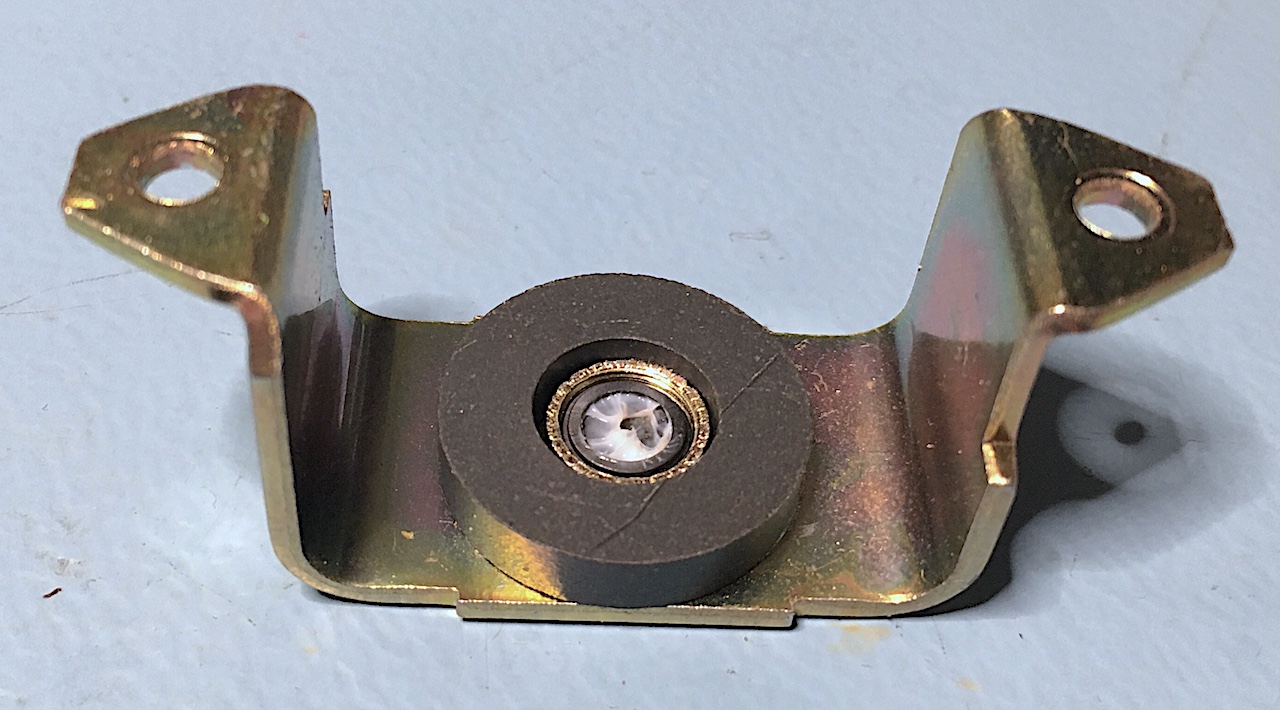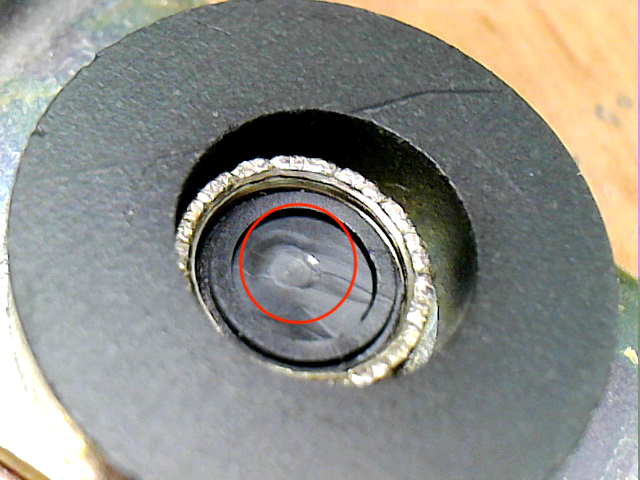I made an interesting observation with the CDM-1 transport in my Philips based CD-player. I built in a LED connected to the EFAB output of the SAA7210 error correction chip. This output indicates for the SAA7220B/P chip that there is an uncorrectable error in the decoding process, and interpolation will be needed.
The LED is dark on most CDs. It sometimes flashes, not very frequently. But when I play a burnt CD (written on PC) it usually flashes like crazy. If the player is willing to recognize it at all. This CDM-1 does not accept 80 min writable CDs that are common nowadays. I have a more than 20 years old 74 min CD-R, and here comes the strange thing:
At first play the LED did not blink at all. It sometimes blinked only around the end of the CD. But at the second play it blinked very frequently.
After several eject/insert I found that either it has very few errors during one play, or it has many at another play.
My theory is that this might be due to mechanical tolerances in the transport. Perhaps sometimes the CD is better centered, sometimes not.
Interesting, isn't it?
The LED is dark on most CDs. It sometimes flashes, not very frequently. But when I play a burnt CD (written on PC) it usually flashes like crazy. If the player is willing to recognize it at all. This CDM-1 does not accept 80 min writable CDs that are common nowadays. I have a more than 20 years old 74 min CD-R, and here comes the strange thing:
At first play the LED did not blink at all. It sometimes blinked only around the end of the CD. But at the second play it blinked very frequently.
After several eject/insert I found that either it has very few errors during one play, or it has many at another play.
My theory is that this might be due to mechanical tolerances in the transport. Perhaps sometimes the CD is better centered, sometimes not.
Interesting, isn't it?
Could be, but this is a magnetic clamp without any external support. Maybe the disc has some vertical play that the focus servo is unable to follow.
The cone on the disc table in Philips players
was always fixed whereas in many japanese
models it sat on a spring and
the inner hole of the CD pressed it down.
As a result, horizontal mechanical play was defined
by the cone and the guiding motor axis,
but never by the diameter of the inner hole .
Later, almost everyone used fixed cones to cut costs.
I think the diameter of a fixed cone was defined by
14.9mm +/- 0.05. Exact data can be looked up in
the later Philips „CD-Pro“ datasheets.
was always fixed whereas in many japanese
models it sat on a spring and
the inner hole of the CD pressed it down.
As a result, horizontal mechanical play was defined
by the cone and the guiding motor axis,
but never by the diameter of the inner hole .
Later, almost everyone used fixed cones to cut costs.
I think the diameter of a fixed cone was defined by
14.9mm +/- 0.05. Exact data can be looked up in
the later Philips „CD-Pro“ datasheets.
That's an excellent point and one that hadn't occurred to me before.
As a side comment, I've just acquired a Denon DCD-3300 and it has the best turntable motor assembly of any player I have seen so far. Wonderful!
As a side comment, I've just acquired a Denon DCD-3300 and it has the best turntable motor assembly of any player I have seen so far. Wonderful!
I made an interesting observation with the CDM-1 transport in my Philips based CD-player. I built in a LED connected to the EFAB output of the SAA7210 error correction chip. This output indicates for the SAA7220B/P chip that there is an uncorrectable error in the decoding process, and interpolation will be needed.
The LED is dark on most CDs. It sometimes flashes, not very frequently. But when I play a burnt CD (written on PC) it usually flashes like crazy. If the player is willing to recognize it at all. This CDM-1 does not accept 80 min writable CDs that are common nowadays. I have a more than 20 years old 74 min CD-R, and here comes the strange thing:
At first play the LED did not blink at all. It sometimes blinked only around the end of the CD. But at the second play it blinked very frequently.
After several eject/insert I found that either it has very few errors during one play, or it has many at another play.
My theory is that this might be due to mechanical tolerances in the transport. Perhaps sometimes the CD is better centered, sometimes not.
Interesting, isn't it?
Interesting. Thanks for sharing.
Found it. It is the CDM-12 but I assume they never changed
the parameters of the disc-tables diameter. (Height, chamfer of cone etc. for sure)
Anyway, the diameter of the fixed cone needs to be smaller
so that the CD does not become stuck when being loaded / unloaded.
And as metal and polycarbonate expand diffently when becoming warm,
there needs to be play as well.
As I wrote before this problem does not exist with a flexible cone.
It can sit on the motor shaft as tight as a bearing which gives ± 0.05mm tolerance.
In the technical drawing attached there are no tolerances given for the
14.9mm diameter.
According to ISO 2768-1 allowed tolerance is ± 0.1mm
but I assume they milled the cone way more precise.
In the CDM-12 it was molded.
the parameters of the disc-tables diameter. (Height, chamfer of cone etc. for sure)
Anyway, the diameter of the fixed cone needs to be smaller
so that the CD does not become stuck when being loaded / unloaded.
And as metal and polycarbonate expand diffently when becoming warm,
there needs to be play as well.
As I wrote before this problem does not exist with a flexible cone.
It can sit on the motor shaft as tight as a bearing which gives ± 0.05mm tolerance.
In the technical drawing attached there are no tolerances given for the
14.9mm diameter.
According to ISO 2768-1 allowed tolerance is ± 0.1mm
but I assume they milled the cone way more precise.
In the CDM-12 it was molded.
Attachments
I measured two CDM-1 center support with a screw caliper, both are 14.97 mm. The center holes of CDs I could mesure with a slide caliper only, which is less precise. It measured 15.0 mm.
The magnet puck presses the CD hard to the platter support, and during eject the clever mechanism rips it off the support.
In any case, this LED is kind of a quality check.
The magnet puck presses the CD hard to the platter support, and during eject the clever mechanism rips it off the support.
In any case, this LED is kind of a quality check.
Attachments
Now we got it - I forgot that.
I think it is something like a very short M6 metric grub screw.
Here is a page how to adress CDM-0 / CDM-1 problems.
DeepL Translate: The world's most accurate translator
is very good in translating the german text of the following link:
CDM1 Service
I think it is something like a very short M6 metric grub screw.
Here is a page how to adress CDM-0 / CDM-1 problems.
DeepL Translate: The world's most accurate translator
is very good in translating the german text of the following link:
CDM1 Service
- Home
- Source & Line
- Digital Source
- Philips CDM-1 and error correction
